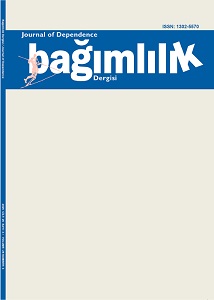Incidence of using substances among high school students and affecting factorsa
Keywords:
adolescent, college students, substance abuseAbstract
Objective: Substance use is an important subject that has been addressed frequently among adolescents in recent years. The aim of this study is to determine the incidence of substance use among high school students and the factors affecting the use of these substances.
Method: This sectional-type study was carried out with 1997 students who were studying in three high schools between 2015-2016 academic year. All of the volunteer students were enrolled in the study that was designed by cluster sampling method. Data were collected by a questionnaire which was developed by the researchers. Questionnaires were distributed to the students by peer educators within the class, and the forms were filled under the supervision of the researchers. Data were analyzed by using mean, standard deviation, number and frequencies, chi-square and multiple polytomous logistic regression model.
Results: In this study ratio of students who have used marijuana once in their lives is 3,6%, who have used ecstasy is 1,6%, and ratio for the volatile is 3,5%. For all of the substances, it is determined that frequency of drug usage is more in students who is male, studied in industrial vocational schools and 12nd grade than others. In addition to this, it is determined that the factors of friends who use substances, unsuccessful school grades, absenteeism, disciplinary punishments and trouble with police increase the usage of substances.
Conclusion: Students’ illegal drug usage frequency shows similarity with study results which have done in other countries and Turkey. It is seen that student sociodemographic characteristics, family, friend and school features are important factors which affect the frequency of drug usage.
References
Karatay GG, Kubilay G. Sosyoekonomik düzeyi farklı iki lisede madde kullanma durumu ve etkileyen faktörlerin belirlenmesi. Hemşirelikte Araştırma Geliştirme Dergisi 2004; 1:57-70.
Ögel K. Madde kullanım bozuklukları epidemiyolojisi. Turkiye Klinikleri J Int MedSci 2005; 1:61-64.
Alikaşifoğlu M, Ercan O. Ergenlerde madde kullanımı. Turkiye Klinikleri J Pediatr Sci 2006; 2:76-83.
Currie C, Roberts C, Morgan A, et.al. (Eds.) Young people’s health in context: International report from the HBSC 2001/2002 survey. WHO policy series: Health policy for children and adolescents. Issue 4. Copenhagen, Denmark: WHO Regional Office for Europe, 2004.
Smith DC, Davis JP, Ureche DJ, Dumas, TM. Six month outcomes of a peer-enhanced community reinforcement approach for emerging adults with substance misuse: a preliminary study. Journal of Substance Abuse Treatment, 2016; 61: 66–73.
Erdem G, Eke CY, Ögel K, Taner S. Lise öğrencilerinde arkadaş özellikleri ve madde kullanımı. Bağımlılık Dergisi 2006; 7: 111-116.
Kann L, Kinchen S, Shanklin SL, et al. Youth risk behavior surveillance United States, 2013. Morbidity and Mortality Weekly Report 2014; 63:1-168.
Ögel K, Taner S, Eke C, Erol B. İstanbul’da öğrencilerde riskli davranışlar araştırması. İstanbul: Yeniden yayın no: 6; 2005:111-116.
Yüncü Z. Adolesan dönemde alkol-madde kötüye kullanımı. Turkiye Klinikleri J FamMed-Special Topics 2013; 4:63-70.
Marschall-Lévesque S, Castellanos-Ryan N, Vitaro, F, Séguin JR. Moderators of the association between peer and target adolescent substance use , Addictive Behaviors 2014; 3: 48–70
Gökgöz Ş, Koçoğlu G. Adelosan çağda sigara ve alkol içme davranışı. Fırat Tıp Dergisi 2007; 12: 214-218.
van den Bree MB, Pickworth WB. Risk factors predicting changes in marijuana involvement in teenagers. Arch Gen Psychiatry 2005;62:311-319.
Brook JS, Brook DW, Arencibia-Mireles O, et al. Risk factors for adolescent marijuana use across cultures and across time. J Genet Psychol 2001; 162: 357-374.
McVicar D, Polanski A. Peer effects in UK adolescent substance use: never mind the classmates? Oxford Bulletin Of Economics And Statistics 2014; 76: 589-604.
Ögel K, Tamar D, Evren C, Çakmak D. Uçucu madde kullanımının yaygınlığı: Çok merkezli bir araştırmanın verilerinin değerlendirilmesi. Anadolu Psikiyatri Dergisi 2000; 1:220-224
Yüncü Z, Aydın C, Coşkunol H, ve ark. Çocuk ve ergenlere yönelik bir bağımlılık merkezine iki yıl süresince başvuran olguların sosyodemografik değerlendirilmesi. Journal of Dependence 2006, 7: 31-37.
Aksoy K. Lise öğrencilerinin bağımlılık yapan maddelere ilişkin tutumları ve bu tutumlara etki eden değişkenlerin incelenmesi (Malatya ili örneği). Yüksek lisans tezi, Malatya: İnönü Üniversitesi Sosyal Bilimler Enstitisü, 2006.
Siqueira I, Diab M, Bodian C, Rolnitzky L. The relationship of stress and coping methods to adolescent marijuana use. Substance Abuse 2001; 22: 157-165.
Evren C, Evren B, Bozkurt M. Tobacco use among 10th grade students in Istanbul and related variables. Asian Journal Of Psychiatry 2014; 8: 69-75.
Kaya B, Özcan ME. Uçucu bağımlılığı ve kötüye kullanımı: Epidemiyoloji, Risk Grupları ve Önleme Programlarının Gerekliliği. Klinik Psikiyatri 1999; 2:189-196
Sutherland I, Shepherd, JP. Social dimension of substance use. Addiction 2001; 96: 445-458.
Görker I. Çocuk ve ergenlerde alkol kullanımı ve alkol bağımlılığı. Turkiye Klinikleri J Psychiatry-Special Topics 2010:3;100-116.
Downloads
Published
Issue
Section
License
Copyright (c) 2025 Journal of Dependence

This work is licensed under a Creative Commons Attribution-NonCommercial-NoDerivatives 4.0 International License.
The Journal and content of this website is licensed under the terms of the Creative Commons Attribution-NonCommercial-NoDerivatives 4.0 International (CC BY-NC-ND 4.0) License. This is in accordance with the Budapest Open Access Initiative (BOAI) definition of open access. The Creative Commons Attribution-NonCommercial-NoDerivatives 4.0 International (CC BY-NC-ND 4.0) allows users to copy, distribute and transmit unmodified article, and make noncommercial use of the article. The CC BY license permits non-commercial re-use of an open access article, as long as the author is properly attributed.

